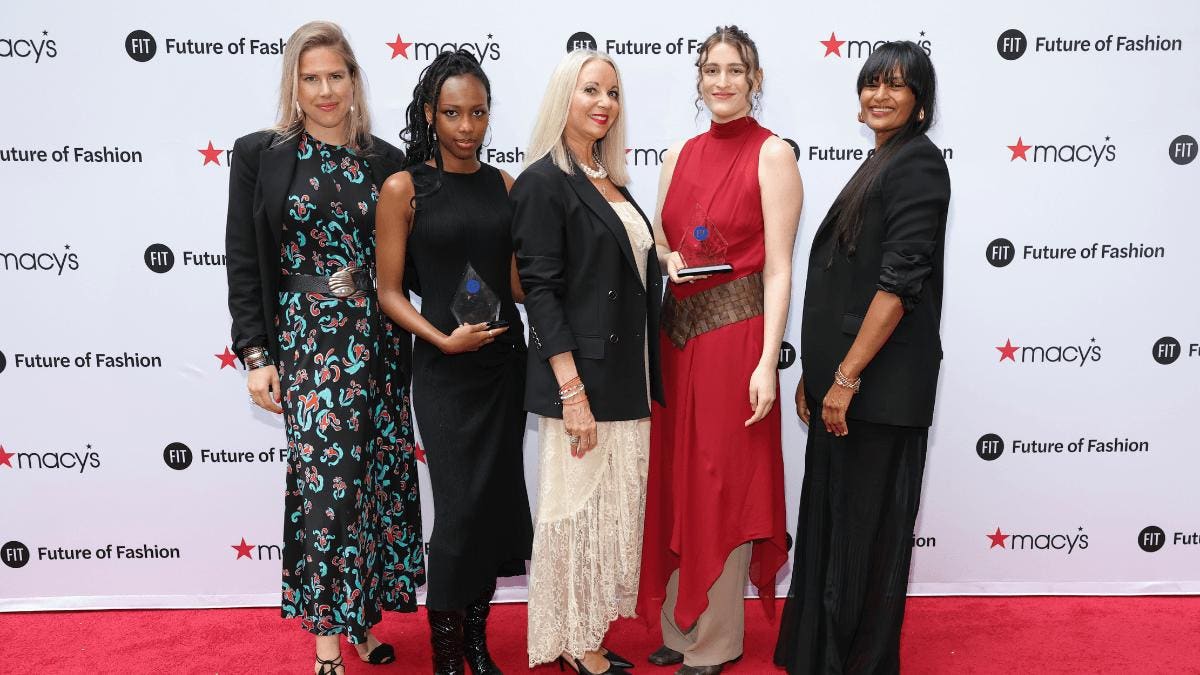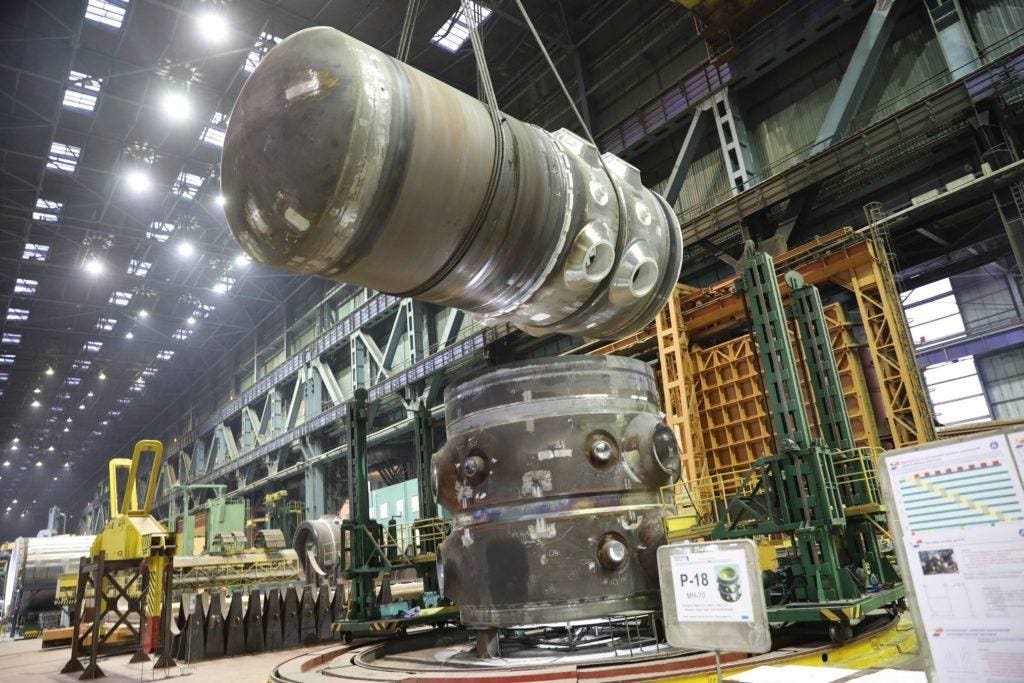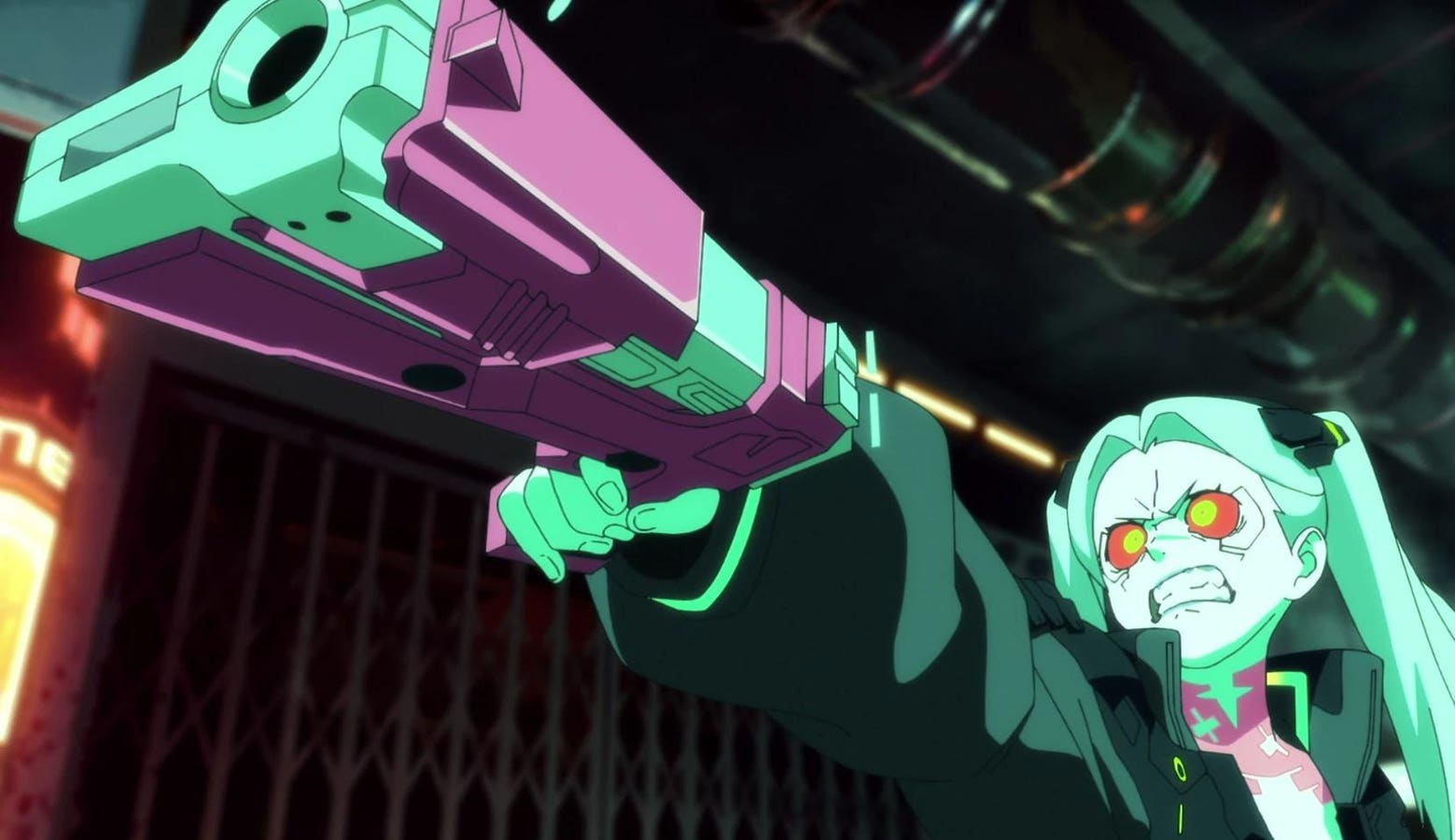The two winners with faculty on the Red Carpet of The Future of Fashion Event. Credit: Michael Loccisano, Getty
Courtesy of FIT
Each spring, at the close of the semester, the best work from graduating students from the Fashion Institute of Technology’s Fashion Design Bachelor of Fine Arts program is chosen to participate in The Future of Fashion. The showcase is a professionally staged runway show and the presentation, representing designers who are sportswear, special occasion, knitwear, and intimate apparel majors, and is judged by a blend of FIT faculty and figures from the fashion industry. At this year’s show, which was back in May of 2025, Macy’s presented two graduates with awards. Khoboso Nale received the X Bar III Capsule Collection prize, which allowed her winning design to be produced and sold by the globally famous department store.
“As a knitwear designer,” Fashion Institute of Technology graduate Khoboso Nale told me, “I focus on crafting textiles from natural materials as much as possible, such as cotton and wool yarns. “I think the biggest struggle is finding your niche and marketing yourself. Designing is more than just creating for yourself; you also create for others as well.”
The young Kenyan-American designer, from Tucson, Arizona, recently won FIT’s Future Of Fashion x Macy’s 2025 Design Capsule Award for a collection she calls Alchemy. She agreed to answer a few of my questions about her work, which the designer feels is connected to her family and heritage. “My culture has a distinct way of dressing where clothing carries power and status,” she said. “Even with limited materials, we still express ourselves artistically in colorful ways. I think this has shaped my own creative journey, which started with expressing myself using whatever I had.”
Sustainability was not always a part of the traditional fashion education, but that is one of many things which have changed in recent years. Today, the best fashion schools have made sustainability a core principle, and the designers graduating from the world’s best design programs, like Nale, are looking at their future careers through a different lens than what the general populace is used to expecting from Fashion.
A close-up view on the details of one of Nale’s designs from her capsule collection, ‘Alchemy.’
Courtesy of Khobosu Nale & FIT
“For my thesis collection,” Nale explained, “I dedicated significant time to researching historical natural dye methods. I discovered just how toxic the dyes used in mass-produced clothing can be and the extent of water pollution they cause. In the past, clothing was not produced on such a massive scale; instead, we worked with the resources available to us, which included natural materials for both yarns and dyes. My goal for the future is to find ways to meet our current clothing needs while ensuring that the production process is not harmful to us or the environment.”
I asked Nale how she came to FIT, what made fashion feel like the world she wanted to explore with her world.
“I had no idea that I could pursue design as a career,” she said to me. “In my first year of college, I was a biochemistry and environmental science major on track for medical school. However, in one of my environmental science classes, I learned about the fashion and textile industry and how much waste is produced, particularly how much of that waste ends up in developing countries like Kenya, where my family is from. That class left a huge impact on me.”
Nale’s class was midway through their program when the Covid 19 Pandemic hit, and she made the decision to take a break from her studies.
“During that time,” she explained, “I spent most of my time designing and growing my hobby. I really grappled with whether I should return to my original path or pursue my passion for design.”
Khoboso Nale, 2025 winner of Macy’s X Bar III Capsule Collection prize at FIT’s The Future of Fashion Event.
Courtesy of Khobosu Nale & FIT
What changed her mind?
“I remembered what I had learned in that class,” Nale said. “The people who can make the most change in the industry are the designers themselves. We have the power to advocate for better choices and to be more self-aware of how the industry affects all of us. Someone once told me in high school that they thought I would become a fashion designer, but I didn’t believe them at the time. However, I held onto those words and became determined to pursue design after realizing how powerful and important it is for the industry to have people who are culturally and environmentally aware. So, I applied to FIT to study fashion design, concentrating in Knitwear, and minoring in Ethics and Sustainability.”
When I said that design students are approaching fashion differently, this is what I meant; students are entering the industry today with as much desire to be a part of systemic changes for good as they are with the desire to make a name for themselves. But let’s back up a little.
The idea that art or design school is easier than attending college or university is an idea that I would happily watch die. A complete fashion education, the sort which turns a student into a viable candidate for professional jobs, requires years of hard work. FIT, like many other fashion-focused institutions, does offer associates degrees, most fashion design students pursue bachelor’s degree programs and many go on to earn master’s degrees.
In addition to the standard core classes all college students must take, fashion design students must also learn to drape, pattern make, and construct garments. They study drawing and illustration and costume history, and get training on the tools and software (hello, autocad) standard for the fashion industry. After completing the basics, students begin to specialize, choosing evening wear, menswear, or any number of specialty areas in apparel design. Khoboso Nale chose knitwear.
Khoboso Nale and her model at the 2025 Future of Fashion runway show presented by Macy’s on May 08, 2025 in New York City. (Photo by Michael Loccisano/Getty Images for Fashion Institute of Technology)
Getty Images for Fashion Institute of Technology
There are essentially two ways that humans tend to make fabrics, weaving or knitting. Yes, felting exists, as does tatting, but when we are talking about mass consumption of clothing, people tend to make and buy clothing made of textiles woven or knitted.
Weaving is done on a loom, and patterns like twill or houndstooth are made by weaving weft (horizontal) yarns over and under warp (vertical) yarns into specific repeating patterns.
Knitting, which can be done by hand or with machines, is the process of creating fabric by making a continuous chain of interconnected loops. (This is why you should NEVER cut a loop which has pulled out of a sweater- the pattern pieces are one giant string and when you cut it everything will eventually unravel.) Knitwear has more stretch that woven textiles, even when using natural fibers like silk, cotton or wool, and before we had extruded plastic fibers like polyester, draping a knit fabric on the bias was literally an innovation in the early 20th Century.
Regardless of fabrics and notions, even separate from subcategories like evening or outerwear, there are some considerations which remain consistent across all apparel design. Color choice, silhouette and textiles are always important to any garment, and I asked the young designer about how she makes those choices in her designs.
“Color is always the first place I start in the design process,” Nale told me. “Color harmony is very important; we spend a lot of time and deliberation creating color palettes. I notice my color palette tends to lean towards earthy tones, influenced by my sources of inspiration. The color palettes that I find most interesting are those that naturally occur in the world around us. Nature has always been a source for me when creating. I genuinely love designing clothes. As a child, I spent a lot of time outdoors, which is where I found much of my inspiration. I draw a lot of my energy from the outside world.”
Douglas Hand, Fern Mallis and Ken Downing attend the 2025 Future of Fashion runway show presented by Macy’s . (Photo by Michael Loccisano/Getty Images for Fashion Institute of Technology)
Getty Images for Fashion Institute of Technology
“Overall, I would say that most of the projects I’ve done are environmentally related or driven,” the designer continued. “My process usually starts with a lot of research, including color research, fabric and yarn exploration, and knitting methods. I begin with a broad perspective and then focus on what is personal and important to me. I have noticed that many of my projects are inspired by nature and incorporate sustainability aspects in various ways, not just in the physical coloring of a garment but also in the construction methods. Knitwear is expansive and versatile, which I find fascinating. I enjoy researching historical knitwear, much of which originated out of a need to produce functional clothing pieces. I had a lot of interesting concepts that I wanted to explore, like the versatility of multi-purpose garments that can be worn in multiple ways.
“The Macy’s Capsule Design Competition was a semester-long project,” Nale explained. “I was chosen as a finalist at the end of 2024 while I was studying abroad in England. The initial stages were conducted remotely, and it often felt like I was throwing darts in the dark. I was thrilled to be selected to participate in the process. During my final semester, I worked hard to produce my look. I received mentorship from Macy’s and invaluable guidance from my professors as well. It was a constant grind, and I spent many sleepless nights sewing and knitting.”
[I have to interject, lovely readers, please forgive me, because mentoring is incredibly important and I never see enough of it. Mentors get just as much out of these relationships, btw, in case anyone was confused and felt as though mentoring was one-sided.]
The full front of one of Khoboso Nale’s winning designs.
Courtesy of Khobosu Nale & FIT
“Ultimately,” Nale said, “my project was chosen as the final winner and will be sold in Macy’s under their Bar III brand next spring. I am very grateful for this opportunity, and the entire experience has been a major learning process for me. Macy’s allowed me to meet with their factory production team, where I gained insights into the production process. These experiences have been invaluable in helping me grow my knowledge and skills as a young designer.”
I asked what she was most proud of in Alchemy, what about the collection was most connected to who she is as a designer.
“What always surprises me is the endless amount of trial and error I had to go through just to achieve the final product,” Nale told me. “Nothing really comes out exactly the way you expect it to on the first try. Particularly during my research into dyeing methods, I started out using food waste to dye scraps of yarn and fabric that I had. I then explored historical dyeing techniques, which took a lot of time, research, and practice. Historical methods often utilized sustainable practices, such as zero waste and mending, and I strive to incorporate these into my designs. This led me to the practice draping on others and myself to develop a concrete idea of how such designs could work. I also took an interest in natural dyeing and did extensive research in that, as well. Seeing my ideas take shape was incredibly rewarding.”
For the actual garments, Nale hand-dyed the ombre, and she spent a lot of time thinking about the many ways that the different fibers she was experimenting with would react with the dye. This seems to be a place that required a lot of the trial-and-error she’d mentioned. If you do not know, adhering color to textile is much more like baking than cooking. It is an exacting science, it is unforgiving.
The back of Khoboso Nale’s gorgeous blue knit coat.
Courtesy of Khobosu Nale & FIT
I could not have ended the conversation without asking if her work had a specific message, as we all know, clothing often does, and knowing what it is helps us connect to what we are wearing in a way that is deeper than surface level.
“I would say my core message is that my designs reflect my love for nature,” Khoboso Nale explained. “As designers, we have a responsibility to be aware of harmful practices and to advocate for positive change, as well as to consider global issues. I want to design with intentionality in mind; that is my driving force. In today’s world, our generation is increasingly concerned about environmental change, and I believe this is the direction the industry will move in. In the immediate future, I am excited about launching my thesis capsule collection at Macy’s in Spring 2026! However, in the future, I want to explore starting my own zero-waste knitwear label.”
MORE FROM FORBES








